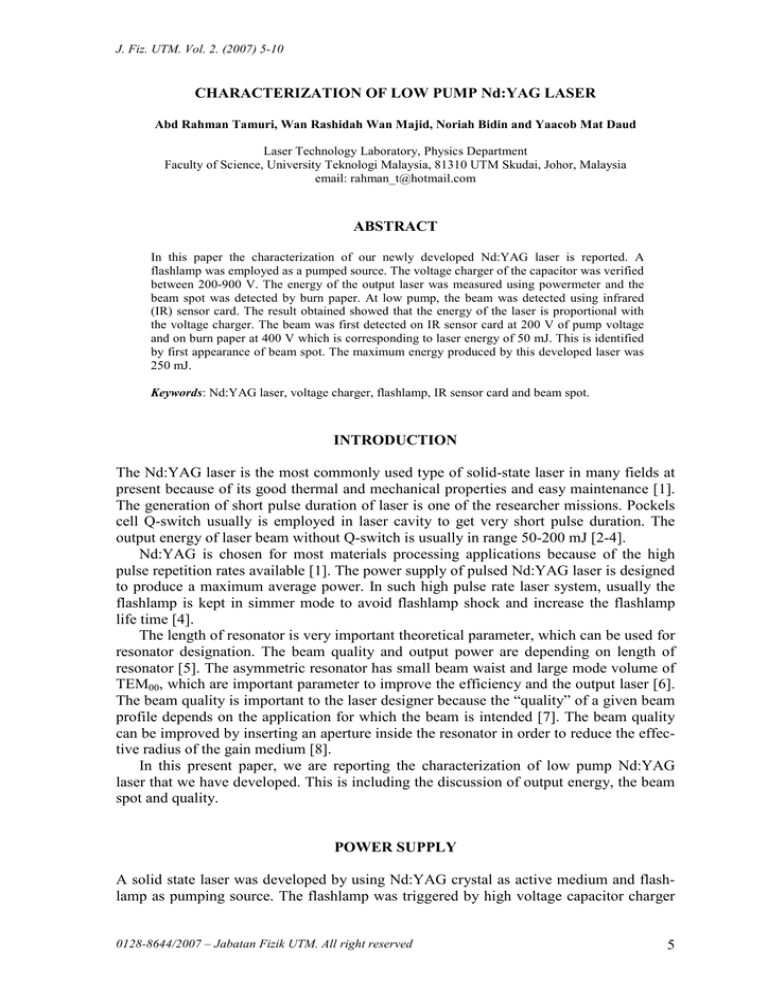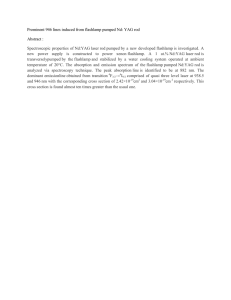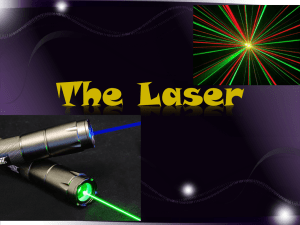CHARACTERIZATION OF LOW PUMP Nd:YAG LASER
advertisement

J. Fiz. UTM. Vol. 2. (2007) 5-10 CHARACTERIZATION OF LOW PUMP Nd:YAG LASER Abd Rahman Tamuri, Wan Rashidah Wan Majid, Noriah Bidin and Yaacob Mat Daud Laser Technology Laboratory, Physics Department Faculty of Science, University Teknologi Malaysia, 81310 UTM Skudai, Johor, Malaysia email: rahman_t@hotmail.com ABSTRACT In this paper the characterization of our newly developed Nd:YAG laser is reported. A flashlamp was employed as a pumped source. The voltage charger of the capacitor was verified between 200-900 V. The energy of the output laser was measured using powermeter and the beam spot was detected by burn paper. At low pump, the beam was detected using infrared (IR) sensor card. The result obtained showed that the energy of the laser is proportional with the voltage charger. The beam was first detected on IR sensor card at 200 V of pump voltage and on burn paper at 400 V which is corresponding to laser energy of 50 mJ. This is identified by first appearance of beam spot. The maximum energy produced by this developed laser was 250 mJ. Keywords: Nd:YAG laser, voltage charger, flashlamp, IR sensor card and beam spot. INTRODUCTION The Nd:YAG laser is the most commonly used type of solid-state laser in many fields at present because of its good thermal and mechanical properties and easy maintenance [1]. The generation of short pulse duration of laser is one of the researcher missions. Pockels cell Q-switch usually is employed in laser cavity to get very short pulse duration. The output energy of laser beam without Q-switch is usually in range 50-200 mJ [2-4]. Nd:YAG is chosen for most materials processing applications because of the high pulse repetition rates available [1]. The power supply of pulsed Nd:YAG laser is designed to produce a maximum average power. In such high pulse rate laser system, usually the flashlamp is kept in simmer mode to avoid flashlamp shock and increase the flashlamp life time [4]. The length of resonator is very important theoretical parameter, which can be used for resonator designation. The beam quality and output power are depending on length of resonator [5]. The asymmetric resonator has small beam waist and large mode volume of TEM00, which are important parameter to improve the efficiency and the output laser [6]. The beam quality is important to the laser designer because the “quality” of a given beam profile depends on the application for which the beam is intended [7]. The beam quality can be improved by inserting an aperture inside the resonator in order to reduce the effective radius of the gain medium [8]. In this present paper, we are reporting the characterization of low pump Nd:YAG laser that we have developed. This is including the discussion of output energy, the beam spot and quality. POWER SUPPLY A solid state laser was developed by using Nd:YAG crystal as active medium and flashlamp as pumping source. The flashlamp was triggered by high voltage capacitor charger 0128-8644/2007 – Jabatan Fizik UTM. All right reserved 5 J. Fiz. UTM. Vol. 2. (2007) 5-10 operating in the range of 0 - 900 V. The energy was stored in capacitor of 150 µF. The laser can be operated either in a single mode or repetition mode with a rate up to 5 Hz. Igniter Circuit Control unit PIC16F84A HV Transformer Discharging Capacitor Simmer Current Supply Xenon flashlamp Figure 1: Block diagram of the overall circuit in simmer current supply Figure 1 shows the block diagram of simmer flashlamp driver. Four main circuits have been developed to drive xenon flashlamp. There were simmer current supply circuit, discharge capacitor circuit, ignition circuit and control unit. The xenon flashlamp was connected in series to simmer current supply through high voltage (HV) transformer. The HV transformer has two main functions, one to allow simmer current through it to xenon flashlamp and to gain the high voltage to flashlamp during ignition process. The ignition process is to breakdown the gaseous in the flashlamp and then the simmer supply will maintain the flashlamp in simmer mode by supplying the constant current in range 0.1 to 0.5 A. LASER RESONATOR The schematic diagram of the experimental setup is shown in Figure 2. The laser resonator consists of two mirrors; output coupler is a flat mirror with 90% reflection and rear mirror is concave of 100% reflection and the radius of curvature of 5 m. The resonator length was set at 40 cm. The active medium comprised of Nd:YAG laser rod with dimension of 4x 60 mm. The ends of the rod are flat, parallel, polished and coated one with antireflection and the other with thin film of 1064 nm. The rod and flashlamp are cooled with pure water during pumping process. In this experiment a plano-concave resonator has been utilized. The radius of curvature of mirror 1, R1 is infinite and R2 is 5 m. The length of laser resonator, d = 40 cm. The beam energy was verified with the capacitance voltage and measured using power meter. The beam spot of the laser beam was determined by using burn paper and IR sensor card. 0128-8644/2007 – Jabatan Fizik UTM. All right reserved 6 J. Fiz. UTM. Vol. 2. (2007) 5-10 Electronics line Beam line Water line d Output Coupler Power meter Laser rod Rear Mirror Beam splitter Laser Chamber Spectrum Analyzer Cooling System Flashlamp Driver Figure 2: Experimental setup for characterization of Nd:YAG laser EXPERIMENTAL RESULT The output of the new developed Nd:YAG laser was first detected by using spectrum analyzer. This is to ensure the laser should produce the infrared range. The typical result obtained from this analysis, confirmed that our new developed laser has generated similar fundamental wavelength of 1064 nm. The spectrum produced from this Nd:YAG laser has lines in range of 600-1100 nm, with dominant wavelength of 1064 such as depicted in Figure 4. We like to notify that, our spectrum analyzer has a limited range of detection limit which is up to 1100 nm only. Therefore any other spectrum beyond this wavelength cannot be detected and displayed on the monitor. The output of the laser was studied by verifying the charging voltage of the capacitor. The data measured are represented in graph of Figure 5. The graph shows the output of the Nd:YAG laser linearly increases with charging voltage. The laser output was first detected at voltage of 200 V which corresponds to laser energy of 4 mJ. Since the maximum voltage for charging capacitor in this studied is 900 V, so the maximum output of Nd:YAG laser that could be achieved is up to 250 mJ. This is in good agreement with the result obtained by other researchers [1]. At low voltage, the beam was detected using IR sensor card. The card will show a red spot if the IR signals appear on the sensor card. The intensity of the beam is dependent on the output energy of the laser. In this report, we have measured the output laser beam as low as 180 V of pump voltage. Figure 6 shows the beam on IR sensor card for various pump voltages up to 220 V. 0128-8644/2007 – Jabatan Fizik UTM. All right reserved 7 J. Fiz. UTM. Vol. 2. (2007) 5-10 1064 nm Figure 4: Spectrum of Nd:YAG laser with dominant of 1064nm . 250 Output Energy, mJ 200 150 100 50 0 0 200 400 600 800 1000 Charger Voltage, V Figure 5: Laser output of developed Nd:YAG versus charging voltage. 190 V 200 V 210 V 220 V Figure 6: Laser beam spots on IR sensor card at low pump voltage 0128-8644/2007 – Jabatan Fizik UTM. All right reserved 8 J. Fiz. UTM. Vol. 2. (2007) 5-10 The beam spot of Nd:YAG laser is determined by using burn paper. The typical observation results are shown in Figure 6. The pictures are arranged in the increasing order of charging voltage. The beam spot was first appeared when capacitor charging voltage was 400 V which corresponds to output energy of 50 mJ. 400 V 500 V 600 V 700 V 800 V 900 V Figure 6: Beam spots at different pump voltages of Nd:YAG laser: The threshold energy for detecting the beam spot is much higher compared to the output energy. The possible reason for this matter could be due to the sensitivity of the material for measurement. Semiconductor material in photodetector is more sensitive since the absorption with small number of photons is enough to convert the light to electrical signal. In contrast to burn paper which is developed by emulsion required high energy to cause contamination. As a result burn paper needs much higher energy for burning purposes. CONCLUSION The new Nd:YAG laser had been successfully developed. The fundamental wavelength of the laser was 1064 nm. The threshold pump voltage was 200 V and the maximum output energy that could be achieved is up to 250 mJ. The intensity of the laser output was dependent on pump voltage with a threshold value of 190 V. The minimum pump voltage was 400 V which corresponding to 50 mJ of energy and was detected on burn paper. ACKNOWLEDGEMENT The authors would like to express their thanks to Universiti Teknologi Malaysia and the Government of Malaysia through IRPA vote number 74531 for the financial support in this project. REFERENCES [1] [2] [3] [4] Koechner. W, Solid-state laser engineering, (Springer series in optical sciences) Spring-Verlag, New York, 1976, p 106 - 203 Musset. O & Boquillon. J. P, Flashlamp-pumped Nd :KGW laser at repetition rate up to 50 Hz, Applied Physics B –Laser and Optics, 1997, 65:13-18 Corcoran. V. J, McMillan. R. W & Barnoske. S. K, Flashlamp-pumped YAG:Nd laser action at kilohertz rates, IEEE Journal of Quantum Electronics, 1974, p 618620 Fransworth R. P, Wide band, high efficiency simmer power supply for a laser flashlamp, US Patents, No 810399, Dec 17, 1985 0128-8644/2007 – Jabatan Fizik UTM. All right reserved 9 J. Fiz. UTM. Vol. 2. (2007) 5-10 [5] [6] [7] [8] [9] Sasani. M. G, A simple approach to designation of intra-cavity resonator for second harmonics Nd:YAG laser, Optics & Laser Technology, 2005, 39(2007): 225-230 Kim. H. S, Jin-Tea. K & Park J. R, Beam characteristic analysis for an asymmetric single Nd:YAG rod resonator. Optics & laser Technology, 2006, Vol. 38 : 528-533. Seigman A. E, How to (Mabye) measure laser beam quality, Tutorial presented at Optical Society of America Annual Meeting Long Beach, California, October 1997 Ameil A. I, Davidson N, Machavariani G, Hasman E & Friesem A. A, Efficient selection of high order laguerre-Gaussian mode in Q-switched Nd:YAG laser, IEEE J. Quantum Electronics, 2003, 39 (1) : 74-82. Kogelnik. H & Li. T, 1966, Laser beam and resonators, Applied Optics, 5(10): 1550-156 0128-8644/2007 – Jabatan Fizik UTM. All right reserved 10





